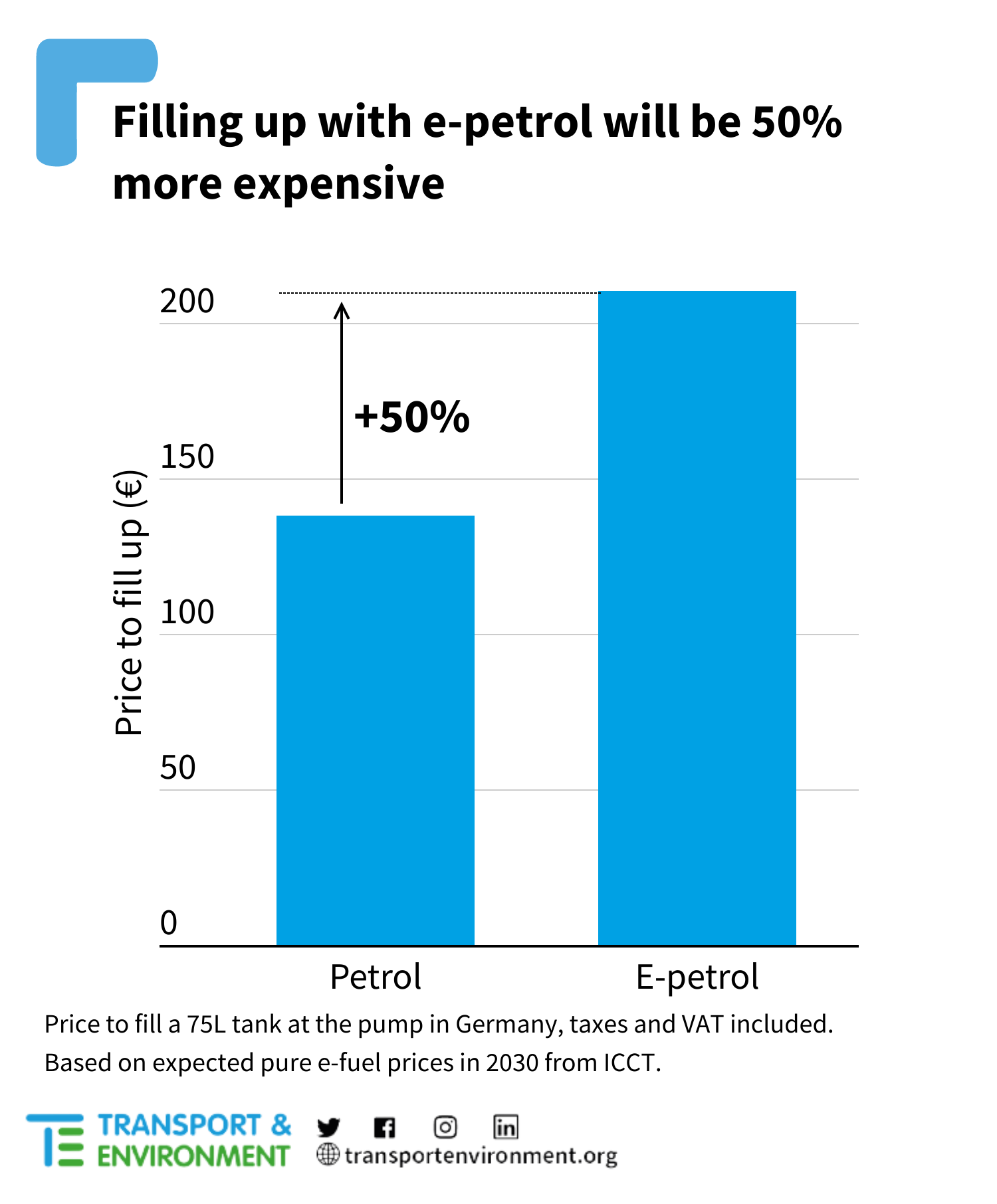In October last year, EU negotiators on behalf of European governments and MEPs reached an agreement on new CO₂ standards for cars and vans. The deal made history as it stipulated that no new polluting combustion engine cars will be sold from 2035. This would put Europe on the path to becoming climate neutral by 2050 and make zero emission cars (mostly battery electric) affordable and accessible to all Europeans.
Just as the EU ministers were about to confirm the single most important law to tackle emissions from road transport, Chancellor Scholz – pressured by his junior coalition partner, the FDP – threatened to block the legislation and pull the rug from under the European Green Deal. U-turning on its previous position, the German government demanded that sales of new cars with internal combustion engines be allowed after 2035, if they run on e-fuels.
Unknown to many, e-fuels – or synthetic petrol and diesel – can in their be made from hydrogen and CO₂. Even though the fuel is burned in engines – so releases similar CO₂ and pollution as conventional cars – provided Direct Air Capture technology is used to capture CO₂ from the air (not yet commercial), the CO₂ captured from the air can neutralise the CO₂ burnt (but not pollution!). These synthetic fuels have, since at least 2017, been pushed by the oil lobby in an attempt to derail the switch to clean electric motors.
German drivers will pay more than €200to fill up at the pump
Producing e-fuelsis a complex and energy intensive process (involving electrolysis to produce hydrogen and complex chemical reactions like Fischer-Tropsch to turn it into a liquid fuel), which means they are expensive to make. Using a cost at the pump in Germany in 2030 of at least €2.8/L, this means an average driver would pay €210 to fill up their tank with e-petrol. Based on current petrol prices in Germany (€1,84/L), filling up with e-petrol will be 50% more expensive than normal petrol. This would place an prohibitive cost on the average driver – a minimum of around €2,300 a year for an average mileage – meaning only the wealthiest drivers would be able to afford to do so. With conventional petrol still available for the existing fleet, it’s likely some drivers would circumvent the rules and buy cheaper petrol for the cars bought after 2035 (the engine is the same), emitting as much carbon as cars do today but treated as “zero emission” cars under the EU car rules.

Wasting e-fuels in new cars is a gift to Big Oil and means fewer solutions to clean up the existing fleet
The deal on the table is about new car sales only, not the existing fleet where solutions like carbon neutral fuels are necessary to decarbonise. In the scenario where e-petrol would be used in new cars, as is being proposed by the German government, they would only displace other zero emission alternatives (electric and hydrogen fuel cell cars) sales without providing any additional CO₂ savings. By using e-petrol in new combustion engines instead of the existing car fleet, the existing cars would burn an additional 135 billion litres of fossil petrol and emit an extra 320 MtCO₂e by 2050 than would otherwise be the case.
Rather than helping Europe meet its climate targets though, Scholz’s plan would derail the decarbonisation of the new fleet while allowing more conventional oil to be used in the existing fleet post 2035 – a win-win for Big Oil. Furthermore, there is no regulatory framework in place to control or verify that these fuels are always carbon neutral, opening the door to fraud.
E-fuels risk repeating the mistakes of the past and creating a new fuel dependency for the EU
Even before the additional demand that would come from using e-fuels in cars is taken into account, Germany will need to import 72% of its green hydrogen demand. To meet this, Germany and Europe will have to import significant volumes of both e-fuels and hydrogen (needed to produce the e-fuel) from abroad. Middle-Eastern countries like Saudi Arabia are among the closest and most viable options and in 2021 a memorandum of understanding was signed between Germany and Saudi Arabia envisaging green hydrogen exports to Germany.
Switching from importing conventional to synthetic fuels only risks continuing Europe’s dependency on autocratic regimes, as with today’s oil. The German focus on Chile as a potential production hub also ignores the fact that e-fuels will only create new energy dependencies. Unlike oil, raw materials for batteries are dispersed around the world (e.g. Europe can supply over half of the lithium it needs by 2030 domestically), and the growing battery investments mean we can be self-sufficient this decade.
Cars powered by e-fuels still emit pollution at the tailpipe – unnecessarily damaging people’s health
Burned in an internal combustion engine (ICE), e-petrol and e-diesel still emit CO₂ and air pollutants, notably toxic NO2 and carcinogenic particles. Based on optimistic assumptions about the availability of e-petrol, if 46 million new conventional and hybrid cars would be sold by 2050 and would be fuelled by pure e-petrol, these vehicles would still emit 160 thousand tonnes of NOx – more than Italy’s entire fleet NOx emissions in 2019. Scholz’s plan for e-fuels risks condemning Europeans to breathe toxic air for decades to come.
Scholz’s plan for e-fuels undermines investment certainty in a multi-billion dollar industry
Ultimately e-fuels will be no more than a niche solution for the likes of Porsche drivers. But by delaying and undermining the clarity of the cars regulation, Scholz is risking up to €30 billion in battery plant investments in Germany just as the race to secure batteries and critical metals is gathering pace between China and the US.


